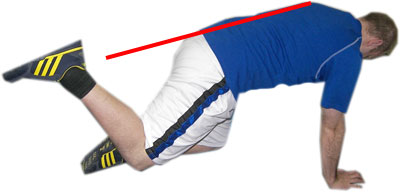Sit-ups-Mistakes to Avoid in Core Training
This is the first article in a series of articles meant to deal with possible errors while training.
Are you stuck in the stone ages of core training? If you only do
crunches or sit-ups you are. The whole core is made up with more
musculature than just what the crunch or sit-up works. At the very heart
of core training is building core stability, strength and power using a
variety of exercises.
One of the primary responsibilities of the core is stabilization.
Imagine you are carrying something heavy. The core is working to
keep the mid section of the body stiff so that you don’t collapse
while lifting that object over head. What about in soccer?
What happens when sprinting one way then all the sudden stopping to
make a cut the opposite direction? If you have a weak core the
result will be “energy leaks.” This basically means weak areas in
the body where energy leaks out resulting in loss of optimal
functionality. For example, let’s say that after sprinting you make
that drastic cut mentioned above. If you have a weak core where
energy leaks out, the result could be the upper body
continuing its forward motion while you are trying to cut the other
way. This is an energy leak that results in less athletic soccer
players.
Your core training should address and fix energy leaks. These types
of energy leaks can result in overcompensation followed by injury.
Sit-ups and Crunches alone will not necessarily overcome these
leaks.
So what does modern core training consist of? Here are some of the areas to include in your current training program (1):
- Reverse crunches-works the external obliques.
- Draw in exercises- trains the transverse abdominus. This is basically drawing your belly bottom towards your spine like you are trying to squeeze into a tight pair of pants or trying to squeeze into a tight location.
- Crunches-We all know what this
is. Keep it to crunches not sit ups.
Medicine ball throws against a wall-This builds power. These would include throws from the side, overhead, front etc. - Bridging-Another stability exercise. Both front and side bridges. Because stability implies no movement your stability core training program should use exercises with no movement. Bridging is a great exercise for this. Here is a picture with illustrations of bad technique when doing the bridge. The upper line shows how my body does not form straight line from shoulders to ankle. The lower line shows how the body should be. When doing the bridge exercise don't allow the athlete to stick his/her butt up or sag midsection down. Go for a straight line. Do this anywhere from 2-3 sets of 10-60 second holds. If you have a weak core start on your knees.

- Gluteus Maximus and Medius exercises- A butt that does not fire correctly can result in a hamstring that overcompensates for the gluteus thus resulting in injury. Never do a core training program without training your gluteus. Good exercises that work the gluteus muscles are Quadruped for Glut Max and Band walks for Glut Medius.
Quadruped-When doing the exercise get on all fours and lift one leg up behind as seen in the picture. When lifting the leg do not extend the lumbar spine. Focus strictly on having the gluteus move the leg. By bending the leg you take a lot of the hamstrings out of the movement so it remains a gluteus movement. Here is the next key. Lift the leg so that there is a straight line from the shoulder, through the butt and back side of the leg. Lift to the red line. When you get to top of movement hold and squeeze the glutes. As you get better at this exercise start to add ankles weights, lift one arm and one leg at a time etc. Do this exercise anywhere from 2-3 sets of 5-10 reps of 4-7 second holds. Remember to squeeze those glutes.

(1) Some of the ideas in this article were taken from Designing Strength training programs and Facilities by Mike Boyle.
